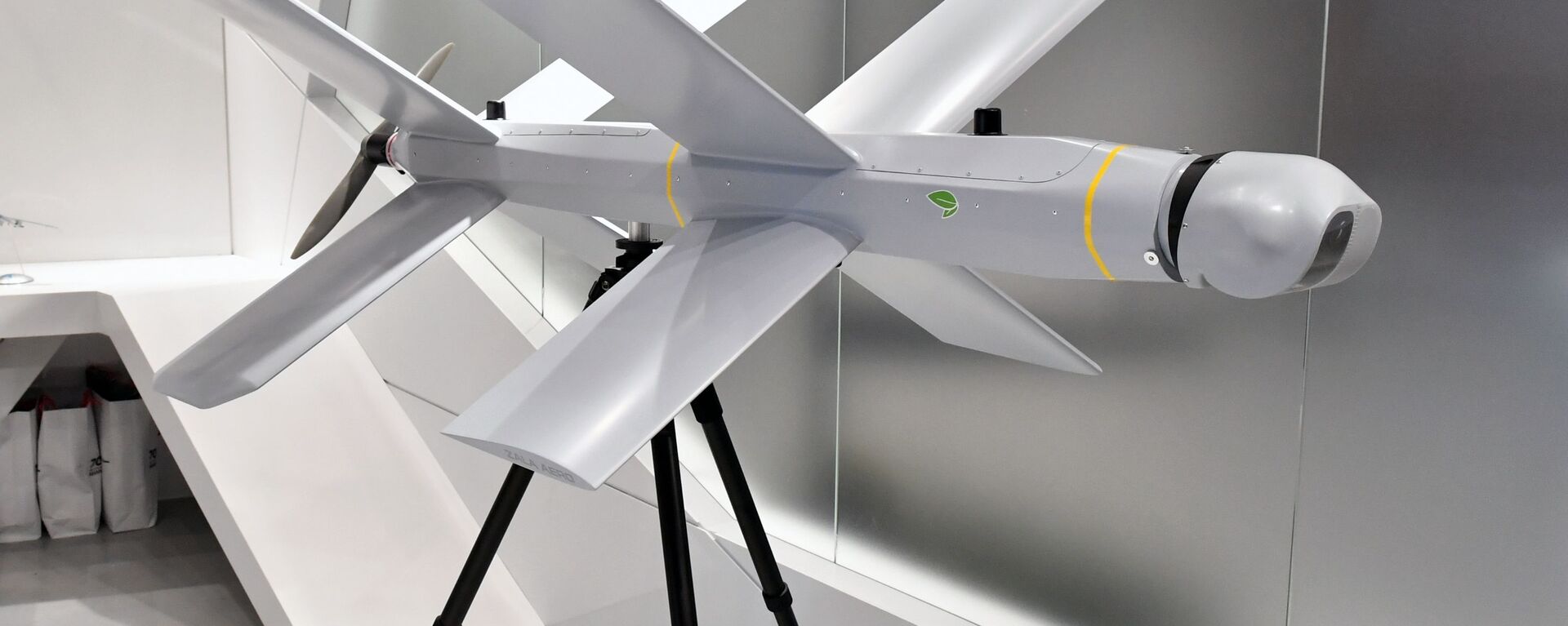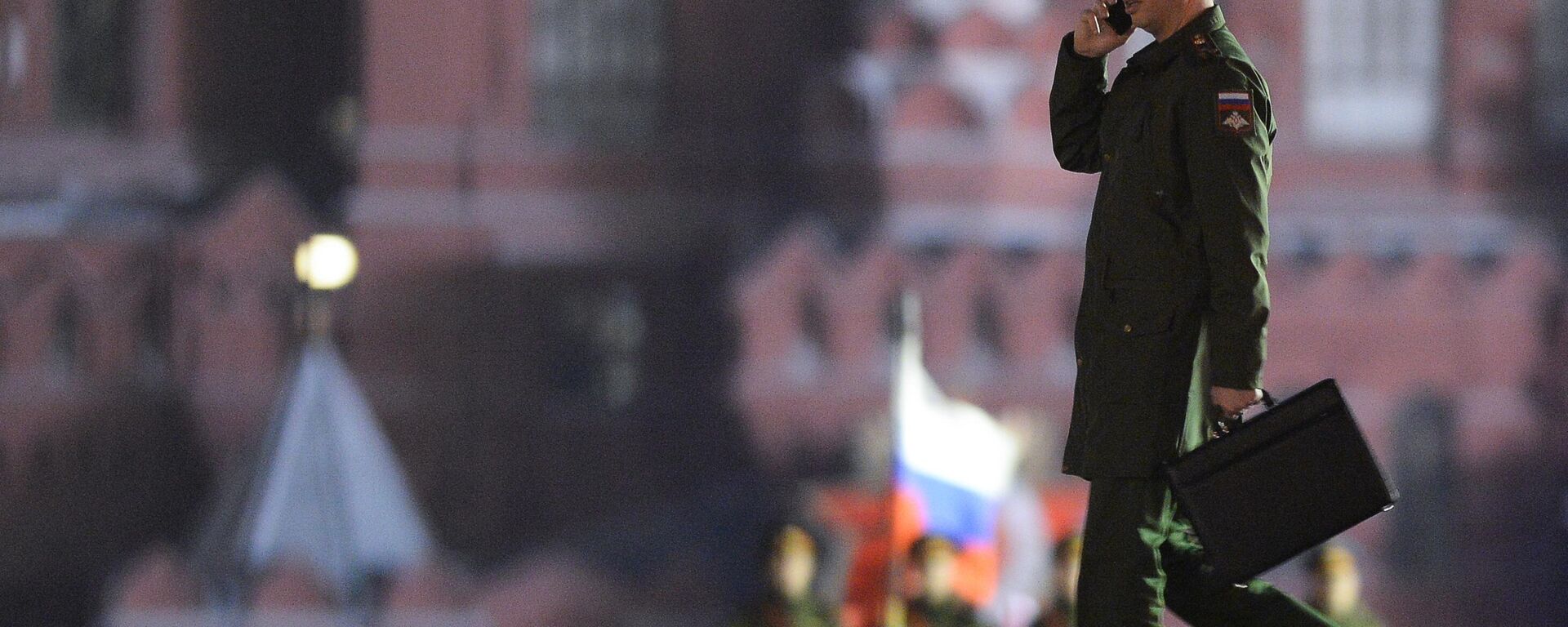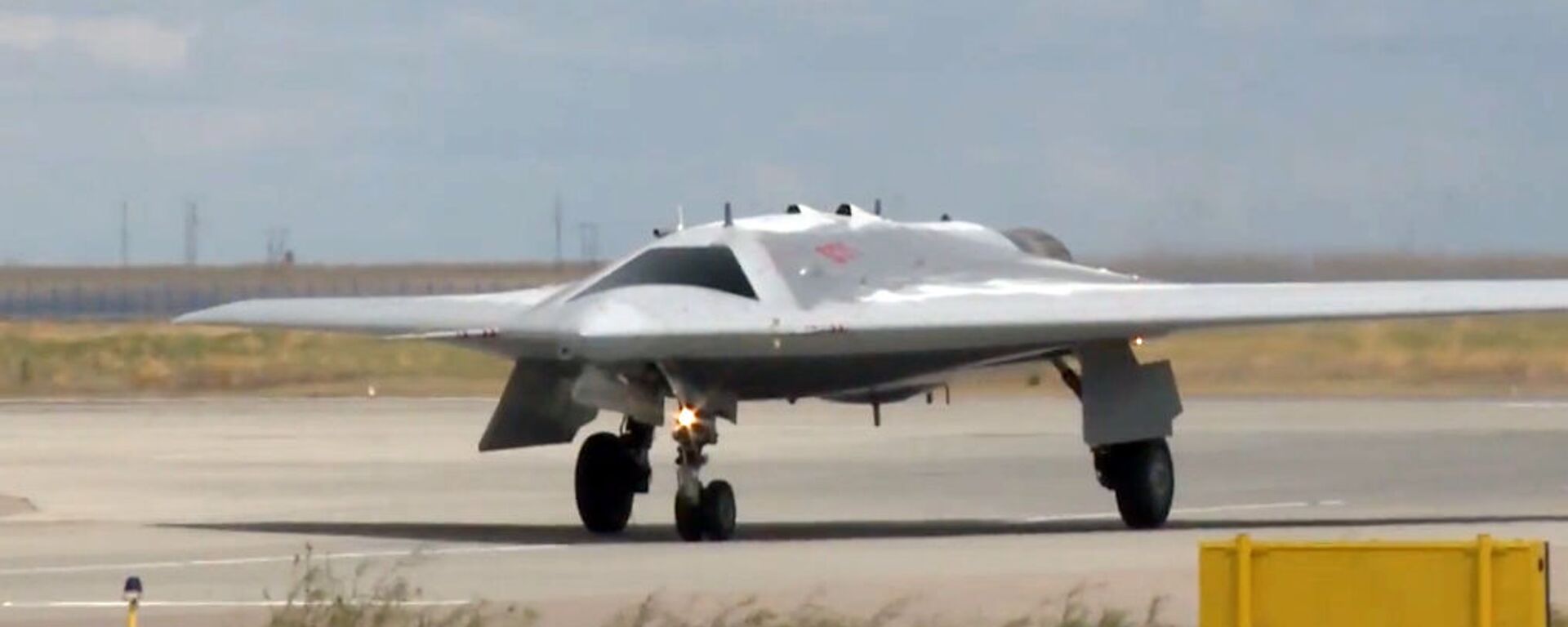https://sputnikglobe.com/20230424/russia-brings-focus-on-development-of-military-drones-electronic-warfare-1109782683.html
Russia Brings Focus on Development of Military Drones, Electronic Warfare
Russia Brings Focus on Development of Military Drones, Electronic Warfare
Sputnik International
A government meeting on the development of unmanned aircraft involving Russian President Vladimir Putin may be held on April 25, according to some reports. What could be behind the Kremlin's special focus on drone technologies and electronic warfare?
2023-04-24T07:00+0000
2023-04-24T07:00+0000
2023-07-16T05:54+0000
military
drone
russia
anti-uav
electronic warfare
electronic warfare system
ukraine
syria
drone swarm
satellite
https://cdn1.img.sputnikglobe.com/img/07e5/0a/17/1090160554_111:0:1267:650_1920x0_80_0_0_18bbe5ca8c846dc3fe73fb2825327381.png
"In the Ukraine conflict, unmanned aerial vehicles (UAVs) have been widely deployed [by Russia] in various combinations," Viktor Litvinenko, military expert, colonel, artilleryman, candidate of military sciences, participant in combat operations in Afghanistan, and professor at the Department of Missile Forces and Artillery, told Sputnik. "First, they are used for tactical purposes, for reconnaissance purposes. Second, most powerful of them are used for strike operations. And third, these are the so-called multi-purpose drones. And I would like to note that the course towards the development of unmanned aircraft is now one of the fundamental ones. Why? Because drones have become part of the means of firepower."On April 25, a meeting on the development of drone technology chaired by Russian President Vladimir Putin could presumably take place. Earlier, in December 2022, Putin instructed the Russian government to launch the mass production of UAVs in the country. By June 2023, the government should prepare a strategy for the development of unmanned aircraft until 2030.UAVs and Swarm Drone Systems"The strongest leaders in the development of unmanned aircraft were the US, Israel, and Türkiye," continued Litvinenko. "But now we have created a fairly powerful system of drones, such as the medium-level Orlan-10 and Orion-30. Then, heavier drones have already appeared, for example, Okhotnik-1. The most interesting UAVs are multi-purpose drones. For example, there are drones that carry weapons, for example, grenades, and so on. Meanwhile, drones like ZALA Lancet or Geran-2 work on special types of targets, which are heavier, armored objects, like a tank, self-propelled gun, infantry fighting vehicle and a number of other objects. And drones, like Orlan-30, hit objects, including moving ones, with high-precision laser-guided weapons."However, the production of drones is not enough, the military expert pointed out. An operator of unmanned aerial vehicles is an important profession that requires attention, training, and education, as per Litvinenko. "One can say that the production of drones and their transfer to the front, proper training of personnel and well-coordinated work of the team on the ground are the key to victory," the expert said.A swarming system consists of multiple unmanned aerial flying platforms integrated as a single networked system managed by operators. Ideally, the system allows UAVs to cooperate with each other using advanced autonomy, computing, communication and AI protocols.According to Litvinenko, the system can be used both for reconnaissance and strikes and facilitates exceptional survivability. While individual drones can be easily taken down, the pack survives. However, most drone systems still require the involvement of operators, according to the expert.Russia's State-of-the-Art Electronic Warfare SystemsSimultaneously with the strategy aimed at stepping up drone production, Vladimir Putin called for the improvement of electronic warfare systems. There have already been reports saying that Rostec, a Russian state-owned defense conglomerate, is due to complete tests in the coming months and begin mass production of a new generation of electronic warfare (EW) and combat UAVs.Leonkov explained that during the special military operation in Ukraine, Russia has faced a vast variety of unmanned aircraft which required an enormous number of missiles to shoot them down. In those situations, EW systems came in handy, according to the military analyst.It was earlier reported that the Russian military-industrial complex has developed a new electronic warfare system capable of suppressing satellites in geostationary orbit with its signal, i.e. about 36,000 kilometers above sea level. Reportedly, the new EW equipment will not allow Ukrainian drones to work over the front line: it will take down the UAVs operating at frequencies of 2.4-5.8 Hertz.According to the military analyst, Russia's EW complexes have already proven their efficiency in various combat operations and will be further developed to improve their performance in the Ukraine conflict zone."A typical example is the conflict that took place in Transcaucasia between Armenia and Azerbaijan, 44 days of fighting. As soon as the Pole-21 EW complex appeared there, enemy drones, including loitering ammunition, could no longer fly into the territory of this enclave, which was around the city of Stepanakert. That is, as soon as they crossed the border, communication and control were lost with them, they fell, they were damaged, or self-destruction occurred. Therefore, the effectiveness of the electronic warfare complex has already been tested not only in Armenia and Azerbaijan, it has also been tested in Syria," Leonkov concluded.
https://sputnikglobe.com/20230318/russian-lancet-kamikaze-drone-destroys-ukrainian-mlrs-mod-1108526476.html
https://sputnikglobe.com/20230127/russia-developing-swarm-attack-drones-for-battlefield-rostec-ceo-reveals-1106765908.html
https://sputnikglobe.com/20230415/ex-pentagon-officer-russias-robust-capabilities-in-electronic-warfare-second-to-none-1109548524.html
https://sputnikglobe.com/20220415/russias-electronic-warfare-troops-catch-nato-spying-on-russian-cellphones-create-countermeasures-1094784028.html
https://sputnikglobe.com/20220318/watch-russian-drones-eliminating-ukrainian-military-vehicles-and-munitions-warehouse-1093980390.html
russia
ukraine
syria
Sputnik International
feedback@sputniknews.com
+74956456601
MIA „Rossiya Segodnya“
2023
News
en_EN
Sputnik International
feedback@sputniknews.com
+74956456601
MIA „Rossiya Segodnya“
Sputnik International
feedback@sputniknews.com
+74956456601
MIA „Rossiya Segodnya“
russia electronic warfare, russian unmanned aerial vehicles, russian drones, russian swarm attack drones, vladimir putin focus on drone technology and ew, zala lancet drone, okhotnik drone, geran-2 uav, russian drones in ukraine conflict zone, russian electronic warfare systems satellites
russia electronic warfare, russian unmanned aerial vehicles, russian drones, russian swarm attack drones, vladimir putin focus on drone technology and ew, zala lancet drone, okhotnik drone, geran-2 uav, russian drones in ukraine conflict zone, russian electronic warfare systems satellites
Russia Brings Focus on Development of Military Drones, Electronic Warfare
Longread
A government meeting on the development of unmanned aircraft involving Russian President Vladimir Putin may be held on April 25, according to some reports. What could be behind the Kremlin's special focus on drone technologies and electronic warfare?
"In the Ukraine conflict, unmanned aerial vehicles (UAVs) have been widely deployed [by Russia] in various combinations," Viktor Litvinenko, military expert, colonel, artilleryman, candidate of military sciences, participant in combat operations in Afghanistan, and professor at the Department of Missile Forces and Artillery, told Sputnik. "First, they are used for tactical purposes, for reconnaissance purposes. Second, most powerful of them are used for strike operations. And third, these are the so-called multi-purpose drones. And I would like to note that the course towards the development of unmanned aircraft is now one of the fundamental ones. Why? Because drones have become part of the means of firepower."
On April 25, a meeting on the development of drone technology chaired by Russian President Vladimir Putin could presumably take place. Earlier, in December 2022, Putin instructed the Russian government to launch the mass production of UAVs in the country. By June 2023, the government should prepare a strategy for the development of unmanned aircraft until 2030.
UAVs and Swarm Drone Systems
"The strongest leaders in the development of unmanned aircraft were the US, Israel, and Türkiye," continued Litvinenko. "But now we have created a fairly powerful system of drones, such as the medium-level
Orlan-10 and
Orion-30. Then,
heavier drones have already appeared, for example,
Okhotnik-1. The most interesting UAVs are multi-purpose drones. For example, there are drones that carry weapons, for example, grenades, and so on. Meanwhile,
drones like ZALA Lancet or
Geran-2 work on special types of targets, which are heavier, armored objects, like a tank, self-propelled gun, infantry fighting vehicle and a number of other objects. And drones, like Orlan-30, hit objects, including moving ones, with high-precision laser-guided weapons."
However, the production of drones is not enough, the military expert pointed out. An operator of unmanned aerial vehicles is an important profession that requires attention, training, and education, as per Litvinenko. "One can say that the production of drones and their transfer to the front, proper training of personnel and well-coordinated work of the team on the ground are the key to victory," the expert said.

27 January 2023, 16:13 GMT
"When one is talking about the strategy for the development of unmanned vehicles, one should pay a lot of attention to the so-called 'swarming system'," he continued.
A swarming system consists of multiple unmanned aerial flying platforms integrated as a single networked system managed by operators. Ideally, the system allows UAVs to cooperate with each other using advanced autonomy,
computing, communication and AI protocols.
According to Litvinenko, the system can be used both for reconnaissance and strikes and facilitates exceptional survivability. While individual drones can be easily taken down, the pack survives. However, most drone systems still require the involvement of operators, according to the expert.
"Despite the fact that a lot is said about the autonomy of drones (…) they are mostly semi-autonomous drones," Alexei Leonkov, a military analyst and editor of Arsenal of the Fatherland, a Russian military publication, told Sputnik. "In case of an error in the drone's autonomous actions, the operator can always intervene and correct it; or find the drone that is stuck somewhere, for example, or [to redirect] some ground drones that deliver correspondence. So it’s not yet possible to talk about fully autonomous drones which operate being controlled by artificial intelligence."
Russia's State-of-the-Art Electronic Warfare Systems
Simultaneously with the strategy aimed at stepping up drone production, Vladimir Putin called for the improvement of electronic warfare systems. There have already been reports saying that Rostec, a Russian state-owned defense conglomerate, is due to complete tests in the coming months and begin mass production of a new generation of electronic warfare (EW) and combat UAVs.
"Electronic warfare systems have been developing for a long time," Leonkov emphasized. "That is, arguably, Russia is the only country in the world that has specialized electronic warfare systems that target certain radio equipment; high-precision weapons and fuses; and electronic surveillance stations both aviation and ground-based. We have EW systems that can target communication systems, including mobile communication and mobile Internet systems. And we also have EW complexes that can target satellite systems for data transmission, communications, intelligence, and so on. The development of these complexes never stops."
Leonkov explained that during the special military operation in Ukraine, Russia has faced a vast variety of unmanned aircraft which required an enormous number of missiles to shoot them down. In those situations, EW systems came in handy, according to the military analyst.
"There was equipment, but it was mostly experimental, capable of producing a large-scale impact on a large number of unmanned aerial vehicles," Leonkov said. "I have seen several installations of that kind which could immediately cover a large space where they conduct their activity (...) Their power allows you to target a whole group of drones. Therefore, their appearance in the conflict zone was a matter of time. And indeed, as soon as they go into mass production and appear on the line of contact, most of the problems with small unmanned vehicles will be solved. Such complexes will be able to counter-attack swarms of drones, which have not yet been used on a large scale in the zone of the special military operation."
It was earlier reported that the Russian military-industrial complex has developed a new electronic warfare system capable of suppressing satellites in geostationary orbit with its signal, i.e. about 36,000 kilometers above sea level. Reportedly, the new EW equipment will not allow Ukrainian drones to work over the front line: it will take down the UAVs operating at frequencies of 2.4-5.8 Hertz.
"The question is simply how the work of the electronic warfare complex will be organized so that it affects either individual key satellites, both military and civilian, [or groups of satellites]," Leonkov said. "That is, for example, satellites for remote sensing of the Earth, satellites that provide mobile and Internet communications in 5G format. If these satellites operate for military purposes, they become a combat control loop. So, the impact of the electronic warfare complex on them violates their functionality. If the enemy does not understand that commercial satellites are being used for something other than their intended purpose, then they can be made to stop functioning. In principle, there was such a precedent. Elon Musk complained that his satellites had begun to work poorly. Then some of them failed. He had to launch additional satellites from the reserves in order to make continuous transmission of the 5G signal across the entire surface of the planet."
According to the military analyst, Russia's EW complexes have already proven their efficiency in various combat operations and will be further developed to improve their performance in the Ukraine conflict zone.
"A typical example is the conflict that took place in Transcaucasia between Armenia and Azerbaijan, 44 days of fighting. As soon as the Pole-21 EW complex appeared there, enemy drones, including loitering ammunition, could no longer fly into the territory of this enclave, which was around the city of Stepanakert. That is, as soon as they crossed the border, communication and control were lost with them, they fell, they were damaged, or self-destruction occurred. Therefore, the effectiveness of the electronic warfare complex has already been tested not only in Armenia and Azerbaijan, it has also been tested in Syria," Leonkov concluded.







